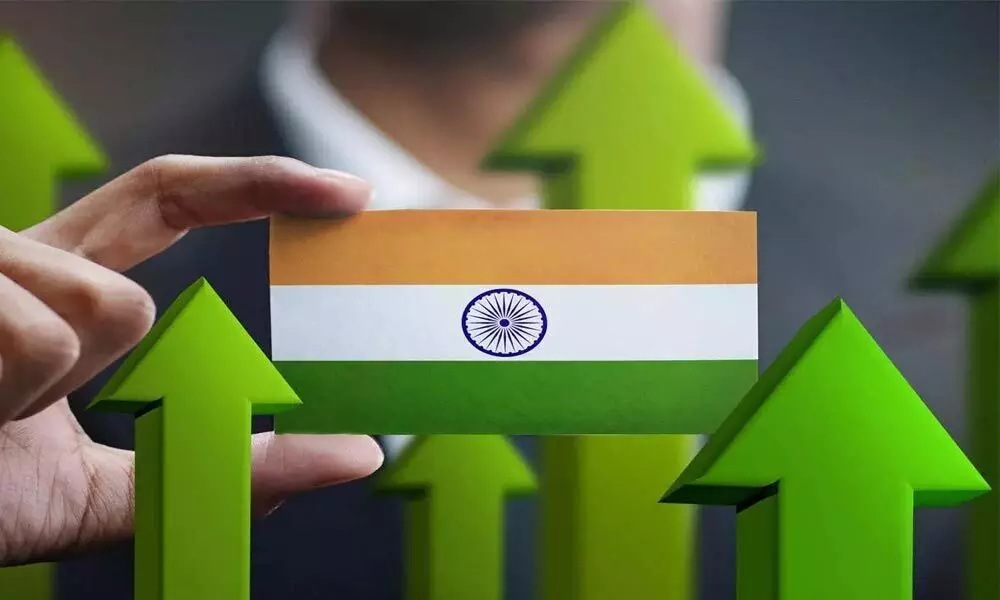Is the Indian economy really back on its feet?
The green shoots of recovery indicating that the growth momentum seems to have returned to the economy are accompanied by other factors that could impede progress
image for illustrative purpose

As the financial year reaches its halfway mark, many key economic indicators are showing an upswing. It looks as if recovery is well on its way but there can be no certainties till growth returns to pre-pandemic levels. For the time being, however, there is much good news. This includes soaring GST (Goods and Services Tax) collections which reached a record level of Rs 1.3 lakh crore in October, a rise of 36 per cent over the same period in 2019. The manufacturing sector has risen for the fourth month in a row with the Purchasing Managers' Index having gone up to 55.9 in October as against 53.7 in September.
To add to the cheer, exports rose by 42 per cent during the month compared to 2019 while non-gold and non-oil imports rose by a healthy 39 per cent. Other positive signals include electricity consumption rising by 4.7 per cent, railway freight loading increasing by 7.6 per cent and petrol consumption by 3.9 per cent. Diesel sales declined by 5 per cent compared to last year but rose by 1.7 per cent compared to 2019.
The outlook is thus definitely on the upswing but it would be premature to declare that the economic recovery is firmly on its way. There are many potential disruptors to smooth upward progress in the current fiscal. The first and most ominous is the rise in global oil prices. The unprecedented surge to around 85 dollars per barrel is worrying for an country that imports 85 per cent of its oil needs from abroad. The rise in prices is being passed through to consumers and the effect is being seen in inflationary pressures on the economy. It has already created hardship for consumers especially vulnerable segments. Soaring fuel prices have a cascading effect on all commodities. Though Diwali shopping is reported to be brisk, many retailers are still complaining that high prices have deterred a return to pre-pandemic sales levels. Growing inflation may in turn force the central bank to pause in its efforts to push growth through monetary policy.
The second issue that may well affect growth momentum is coal supply shortfalls. In case coal companies, especially public sector Coal India, are not able to meet the needs of thermal plants, there could be crippling power shortages. And these in turn will impact efforts to step up industrial production. The situation has eased slightly in October with thermal plants stocks having gone up to six days requirements compared to four days earlier. Even so, the stock situation is precarious and any disruptions of rail supplies could turn out into a crisis.
The biggest responsibility is that of Coal India which accounts for 80 per cent of output. Among the reasons given for the shortfall in supplies in recent months include the heavy rainfall in August and September that affected coal production. But governance issues have also been flagged by former coal industry executives who have public commented that output has not been maintained at required levels in recent years. Yet another factor has been sudden rise in demand after the sluggishness during the pandemic. Even coal importers have not been able to enhance supplies to meet the surge in requirements which seems to have caught both producers and importers by surprise, leading to power outages in several states.
A third global factor that could impede higher output in the manufacturing sector is the shortage of semiconductors or what is known as the ubiquitous chip. The non-availability of chip supplies has already resulted in slowing down of automobile production. But it has also impacted many other sectors including medical devices, and consumer electronics. A continuing shortage of chips could lead to disruptions in output of a wide range of products.
For the long term, this country has entered into an agreement with the Quad countries of the US, Japan and Australia for creating a global supply chain for chips. Currently the bulk of the world's chips production comes from Taiwan, which is now under threat of takeover from China. So many countries are now scrambling to diversify supply sources, given the threatening noises being made by Taiwan's neighbor. The Quad's new semiconductor supply chain plan may take a while to come into effect but is certainly viable in the long term given the relative strengths of each country. In India's case, it has a huge pool of skilled engineering manpower to support the project. In the short run, however, this country will have to rely on chips imports and the continuing shortages in supplies may ultimately affect the economic recovery process.
Thus the green shoots of recovery indicating that the growth momentum seems to have returned to the economy are accompanied by other factors that could impede progress. Besides these, indicators will have to be sustained over the next few months to ensure that the revival path is sustained for the medium term. Another critical element that needs to be kept in mind is the progress in vaccinations. Though epidemiologists appear to be ruling out a disastrous third wave, the experience of many countries shows the withdrawal of the Covid virus cannot be taken for granted in any way. For instance, the US is still recording large numbers affected by the virus while Russia has begun to lock down some parts of the country due to rising cases. It would thus be wise to take a cautious approach and wait for more positive news over the next few months before declaring that economy is back on its feet.

